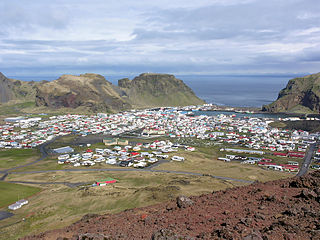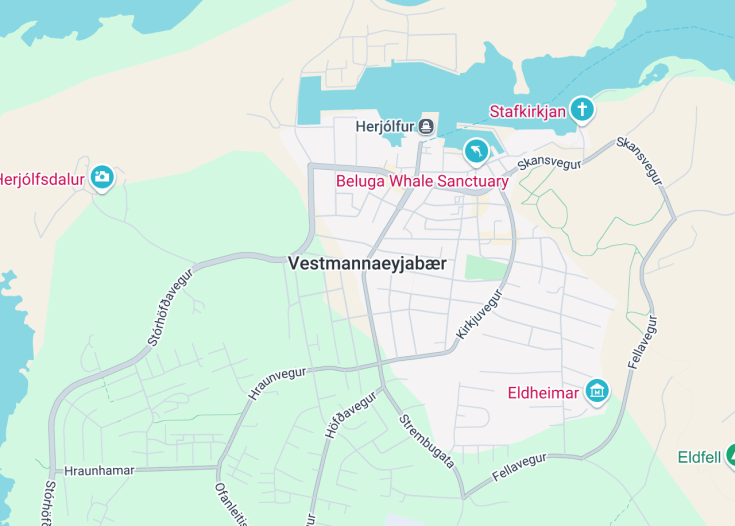Vestmannaeyjabær, nestled in the Vestmennaeyjar archipelago off the south coast of Iceland, is a hidden gem for adventurous travelers. This picturesque town offers breathtaking landscapes, from dramatic volcanoes to tranquil coastlines. Renowned for its pivotal role in Icelandic history, particularly during the 1973 Heimaey eruption, Vestmannaeyjabær provides a unique cultural experience with its vibrant local life and traditional Icelandic festivities. Visitors can explore its rich wildlife, including puffins and other seabirds, making it an ideal spot for nature enthusiasts and history buffs alike.
When visiting Vestmannaeyjabær, pack versatile clothing to accommodate the island’s variable weather conditions, ensuring a comfortable experience while exploring the natural beauty.
Check out the local seafood eateries early in your trip; the fresh catches are a culinary highlight and reflect the rich maritime culture of Vestmannaeyjabær.
Top things to do & see in Vestmannaeyjabær
Select the following sights and activities to discover best tickets and tours available in Vestmannaeyjabær.
Vestmannaeyjabær: A Volcanic Island Gem
| Country | Vestmannaeyjar (Iceland) |
| Time in Vestmannaeyjabær | GMT+0 |
| Language spoken | Icelandic |
| Population | 4,135 (Statistics Iceland, 2023) |
| Currency | Icelandic Króna (ISK) |
| Airports | Vestmannaeyjar Airport (1 mi / 1.6 km) |
Vestmannaeyjabær, a charming and vibrant town located on Heimaey Island in the Westman Islands, Iceland, presents a unique blend of breathtaking sceneries and rich history. Often known simply as the Westman Islands, this small archipelago boasts stunning volcanic landscapes, making it a prominent site for geological and environmental studies. Vestmannaeyjabær itself is the largest town in the islands and serves as the economic and cultural hub.
Historically, Vestmannaeyjabær gained global attention during the 1973 volcanic eruption, which led to a massive evacuation and lastingly transformed the island’s geography and lifestyle. Post-eruption reconstruction has made the town a symbol of resilience and innovation. The Eldheimar Museum, dedicated to preserving the memories of the 1973 disaster, stands as a poignant reminder and a major attraction.
Aside from its dramatic history, Vestmannaeyjabær is renowned for its vibrant annual festival, Þjóðhátíð, where Icelanders gather to celebrate with music, fireworks, and the unique culture of the island. The town also offers rich wildlife experiences, notably watching puffins along the cliffs, which is one of the largest puffin colonies in the world.
With its fishing industry thriving, tradition holds a strong place here, influencing both the livelihood and cuisine of the locals. Visitors can indulge in fresh seafood that is among the finest in Iceland, alongside viewing the operation of Iceland’s largest fishing fleets.
Where is Vestmannaeyjabær?
Vestmannaeyjabær is located in the Westman Islands, off the south coast of Iceland, making it a secluded yet accessible destination.
Distances:
| Route | Distance by car | Time by car |
|---|---|---|
| Reykjavik to Landeyjahöfn followed by ferry to Vestmannaeyjabær | 94 mi (151 km) | Approx. 2 hrs 10 mins |
What is Vestmannaeyjabærfamous for?
Vestmannaeyjabær is famous for its resilience post the devastating 1973 eruption and its prominent puffin populations, hosting one of the world’s largest colonies of these charming birds.
History
Settlement Era: Ancient Times – 874 AD
Icelandic lore tells of the first Norse settlers arriving on the islands of Vestmannaeyjar in the early 9th century, with Herjólfur Bárðarson often credited as the initial seafarer to make a home here. Legend positions these islands as a tranquil refuge, away from the political upheaval of mainland Iceland. Their story weaves through the sparse but ruggedly beautiful landscapes that formed the daily backdrop for these early Viking settlers.
Viking Era & Medieval Period: 874 AD – 1500 AD
Throughout the ensuing centuries, Vestmannaeyjabær evolved into a noteworthy fishing hub. Its strategic location enabled the burgeoning community to capitalize on the bountiful seas. Historical records from the medieval period depict a life rhythm dictated by the ebb and flow of ocean tides, where fishing and bird hunting were essential for survival. However, life was not without its challenges; pirate attacks from North Africa in the 17th century marked a grim chapter in the archipelago’s history, signaling the need for robust defense strategies.
Modern Era: 1500 AD – 20th Century
Entering the modern era, the islands transitioned through significant economic and social changes, reflecting broader European influences. The 18th and 19th centuries saw a formalization of the fishing industry, which became the cornerstone of local economy. The establishment of Vestmannaeyjar’s harbor further legitimized the town as a central player in Northern Atlantic maritime trade.
Contemporary Period: 20th Century – Present
The 20th century bore witness to pivotal moments; most notably, the 1973 volcanic eruption that prompted the entire population to evacuate to mainland Iceland. The rebuilding post-evacuation showcased remarkable resilience, turning disaster into a genesis for modern infrastructural development. Today, Vestmannaeyjabær stands as a symbol of survival, housing a community deeply connected to its historical roots yet agile enough to navigate the demands of contemporary living.
Visit Vestmannaeyjabær
What to see and do in Vestmannaeyjabær, Vestmannaeyjar (Iceland).
Vestmannaeyjabær offers a rich tapestry of experiences for every type of traveler. The Eldheimar Museum provides a poignant glimpse into the town’s volcanic history and the 1973 eruption, and it’s a must-visit for history buffs. Nature enthusiasts will appreciate the abundant wildlife and scenic hikes around the island, such as Helgafell and Eldfell volcanoes, offering panoramic views of the archipelago. For bird watchers, the cliffs surrounding the area are prime spots for puffin sightings, particularly at the beautifully rugged Stórhöfði.
- Eldheimar Museum
- Helgafell and Eldfell volcano hikes
- Puffin watching at Stórhöfði
Festivals and Cultural Celebrations in Vestmannaeyjabær
Vestmannaeyjabær is rich in cultural traditions, notably hosting the annual Þjóðhátíð Festival. This event, held every August, is a vibrant celebration of Icelandic culture, featuring music, dance, and traditional foods. It attracts visitors from across Iceland and around the globe, creating a festive atmosphere that encapsulates the town’s community spirit.
Best time to visit Vestmannaeyjabær
The optimal time to visit Vestmannaeyjabær is during the summer months, from June to August. During this period, the weather is most favorable, the days are longest, and the island’s nature is at its full bloom, offering the best conditions for hiking and wildlife viewing. Additionally, this timeframe coincides with the Þjóðhátíð Festival, providing a unique cultural experience.
Is Vestmannaeyjabær worth visiting?
Vestmannaeyjabær serves as a unique travel destination, offering a blend of natural beauty, rich history, and vibrant cultural experiences. While the town’s remote location and occasionally harsh weather can present challenges, the breathtaking landscapes, wildlife opportunities, and engaging local culture make it an enriching destination for those seeking a distinct and memorable experience. Whether it’s exploring volcanic sites or participating in the annual festivals, Vestmannaeyjabær promises visitors a unique insight into the resilience and charm of Icelandic life.










